Museum's 16 Victoria Crosses on public display for first time
- Published
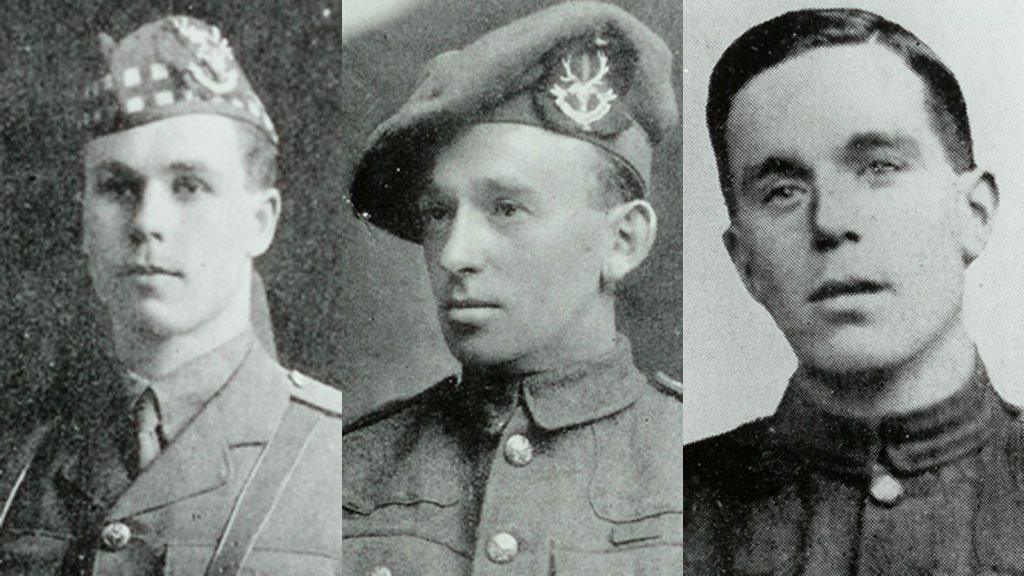
Donald Mackintosh, Alexander Edwards and Robert McBeath, who after the war was killed while working a policeman in Canada
Sixteen Victoria Crosses have gone on public display for the first time.
They were awarded soldiers from across Scotland and England who served with Highlands regiments between 1857 and 1917.
Until now, replicas of the 16 medals have been on display at The Highlanders' Museum at Fort George near Ardersier.
A number of the soldiers were awarded the Victoria Cross posthumously after being killed in action.
They have been put on public display as part of events marking the 250th anniversary of Fort George.
Created in 1856, the medal recognises acts of extreme bravery carried out under direct enemy fire.
The medal is hand-made, traditionally using bronze taken from a gun captured in the Crimean War of the 1850s.

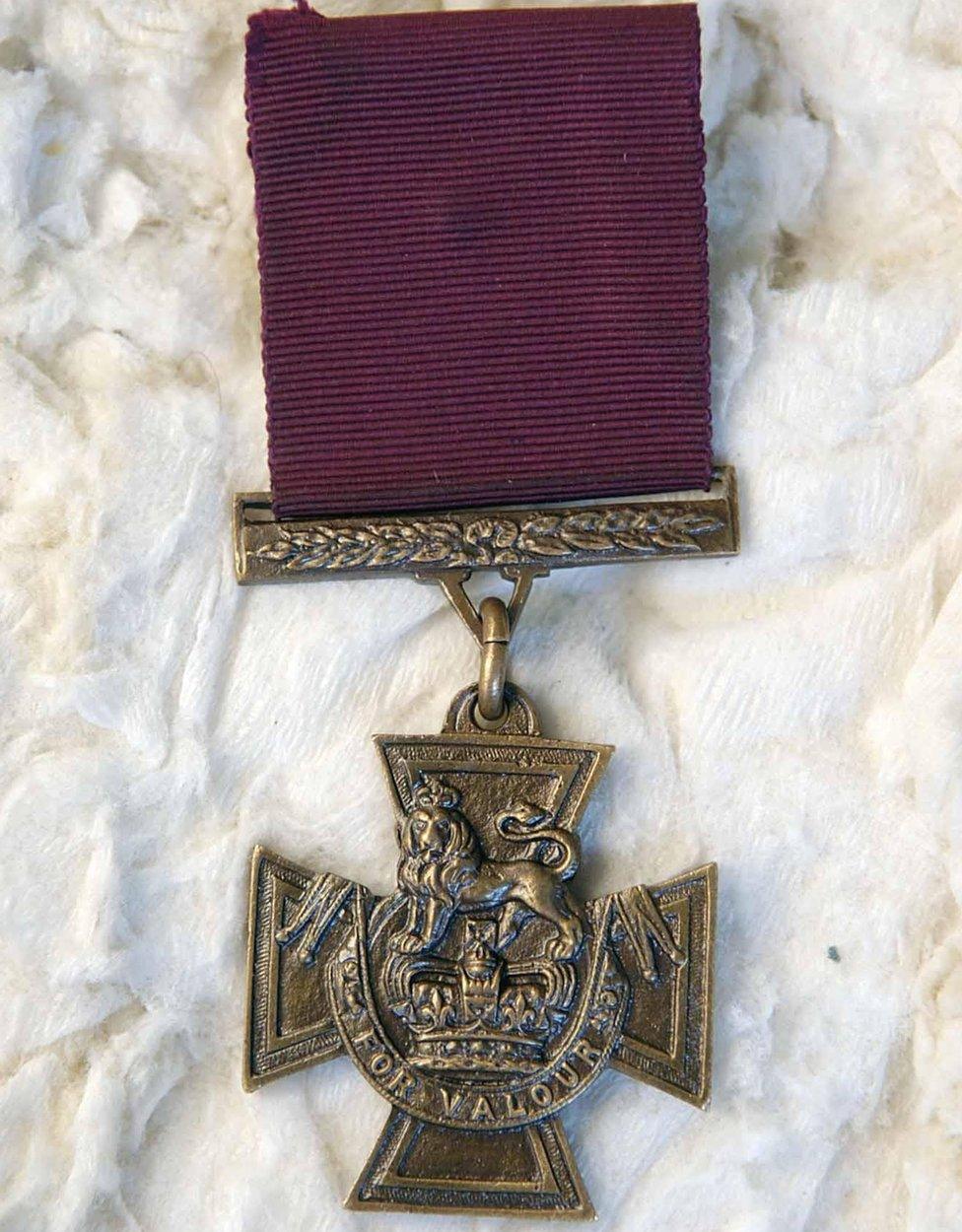
Created in 1856, the medal recognises acts of extreme bravery in military conflicts

The Highlanders' Museum's 16 crosses have until now been held in secure storage.
The decision to put the real medals on public display follows a £2.9m project to revamp the museum that was completed in 2013.
The Victoria Crosses were awarded to soldiers of the 72nd Ross-shire Buffs, 78th Highlanders, Seaforth Highlanders and The Queen's Own Cameron Highlanders.
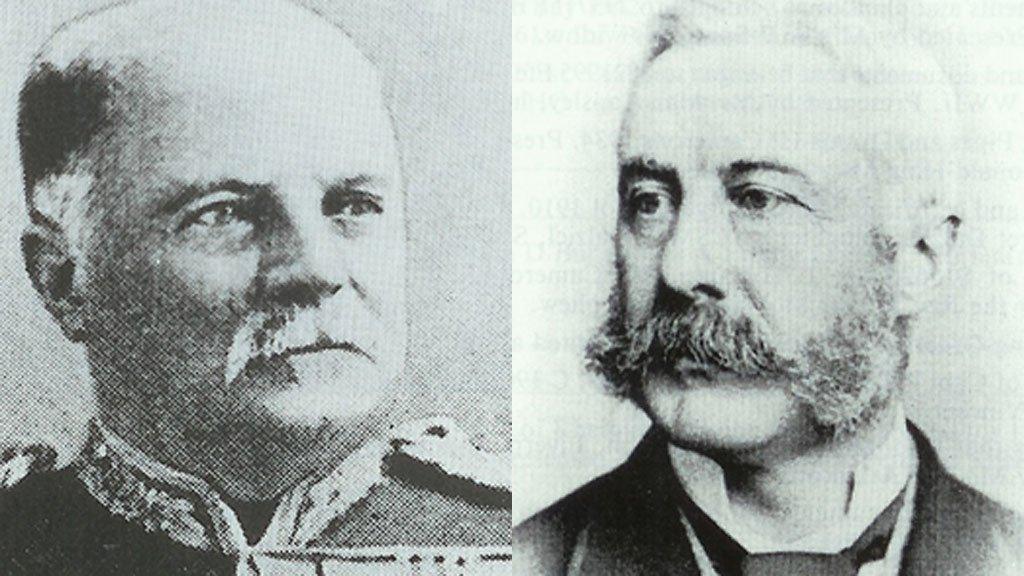
Herbert Macpherson and Andrew Bogle
Glasgow-born Lt Andrew Bogle was the recipient of the first of The Highlanders' Museum's Victoria Crosses.
A member of the 78th Highlanders, he was recognised for "conspicuous gallantry" in July 1857 during the Indian Mutiny.
Lt Bogle, who was severely wounded, received his Victoria Cross from Queen Victoria at Windsor Castle in 1860.
'Line of duty'
The last of the 16 was awarded to L/Cpl Robert McBeath.
He was recognised for a lone attack on a nest of five machine gunners at the Battle of Cambrai in World War One on 20 November 1917.
L/Cpl McBeath captured 33 German soldiers, including three officers.
After the war, he emigrated to Canada and joined the North West Mounted Police.
In October 1922, he was shot and killed by a man that he and another officer had stopped for driving erratically. L/Cpl McBeath was 24 years old.
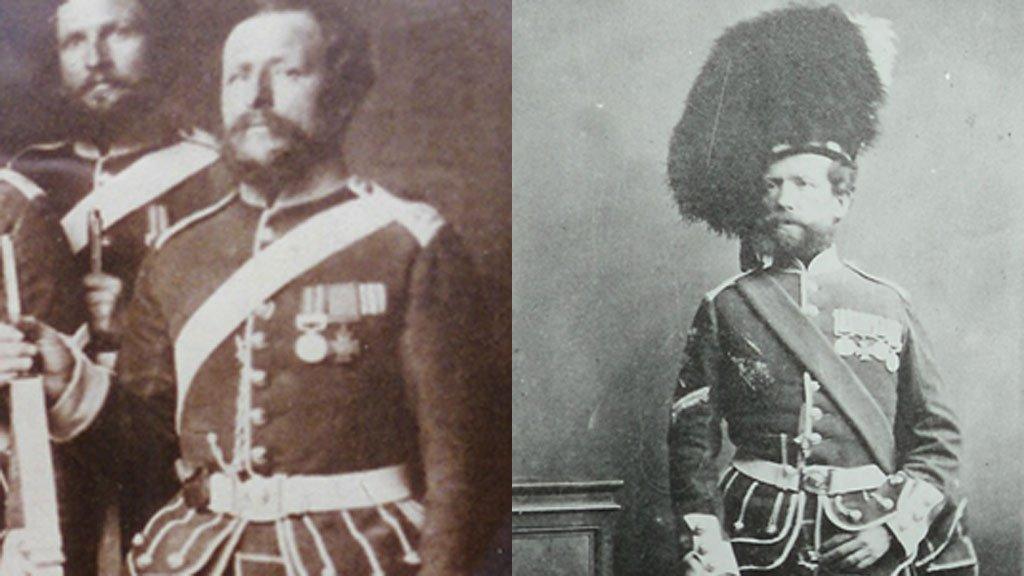
Henry Ward and Stewart McPherson
One of his few surviving relatives, his great-niece Marjorie Buntin, was among descendants of the men who attended an unveiling of the 16 medals at Fort George.
She told BBC Scotland: "He was the illegitimate son of my great-grandmother and she gave him away to a woman who lived in Kinlochbervie.
"He was brought up there and later lied about his age to join the army during the First World War.
"After the war, he went back to Kinlochbervie but found it too quiet and so emigrated to Canada where he joined the Canadian police force and was shot in the line of duty."
Ms Buntin said it was an honour to attend Friday's event.
'Mere mortals'
Museum director Kirstin Mackay said the stories behind each of the medals told of "tremendous bravery in the face of true adversity".
She said: "This is an invaluable part of Highland history and we are proud to have these Victoria Crosses in our collection."
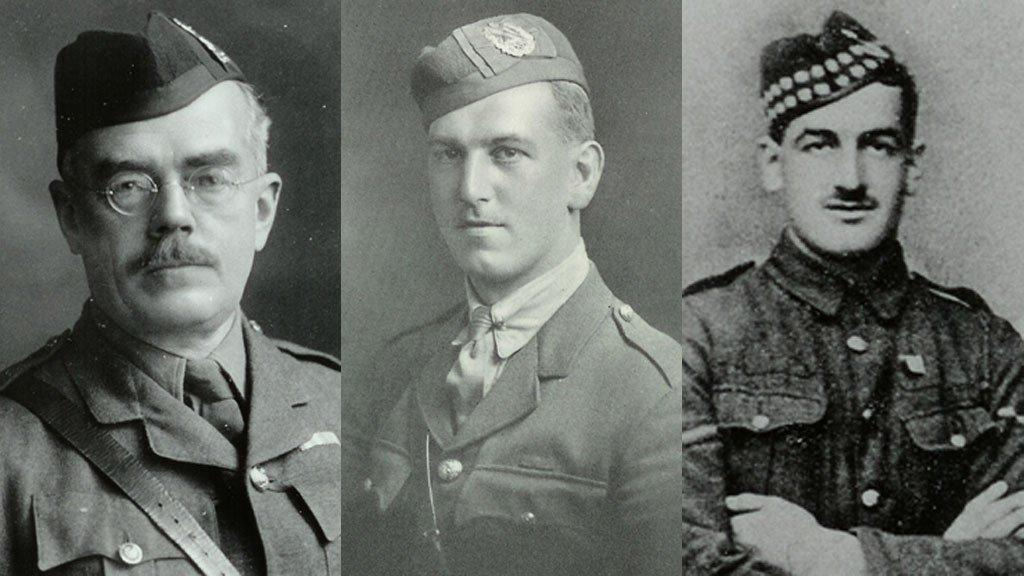
Angus Douglas-Hamilton, James Pollock and Sidney Ware
Curator Ann-Marie Peckham said: "Having the descendants of Victoria Cross winners together in the same room with the 16 decorations is a poignant way to remember the Victoria Cross winners and allows us to reflect on the actions for which they were awarded this decoration as well as the life stories of the men themselves."
Maurice Gibson, chairman of the Highlanders' Museum board, added: "It makes mere mortals like me fully appreciate what these very brave men went through as they went about their business in the heat of battle".

The other Victoria Cross recipients were:
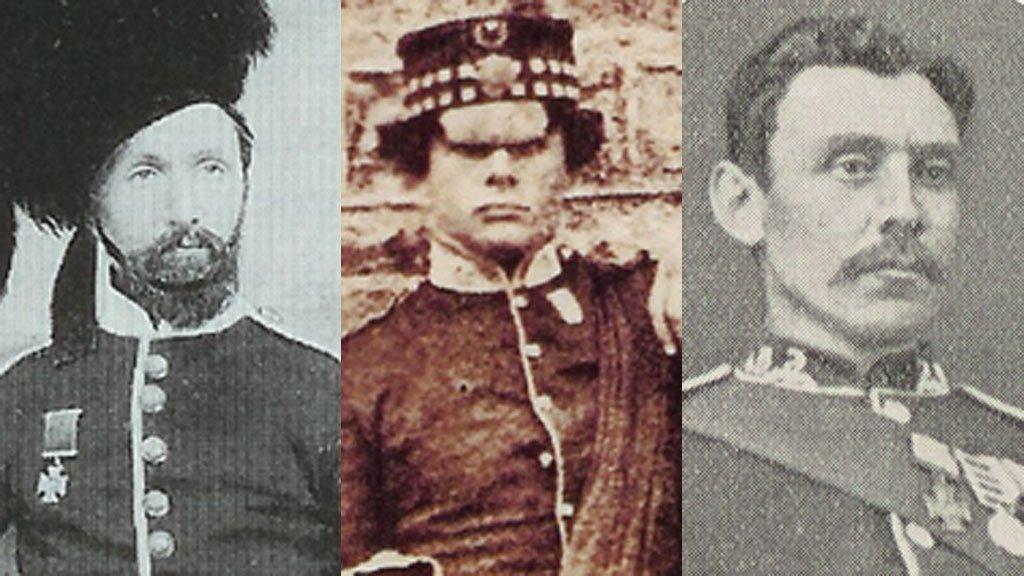
James Hollowell, Aylmer Cameron and George Sellar
Lt and Adjutant Herbert Macpherson. Born in Ardersier in the Highlands, the officer of the 78th Highlanders set an example of "heroic gallantry" in capturing artillery during action to relieve a garrison in the besieged city of Lucknow, India, during the Indian Mutiny, in September 1857.
Colour Sgt Stewart McPherson. From Culross, Fife, he was recognised for his rescue of a wounded soldier and "coolness and gallantry in action" during the defence of Lucknow in September 1857. He served with the 78th Highlanders.
Pte Henry Ward. Born in Harleston, Norfolk, the soldier of the 78th was praised for his bravery while escorting wounded troops while under fire at Lucknow in September 1857.
Pte James Hollowell. From Lambeth, London, the soldier of the 78th Highlanders' citation described his fearlessness and "talent in persuading and cheering" nine "dispirited" fellow soldiers into defending a burning house as they were shot at through the windows of the building during his regiment's capture of Lucknow.
Lt Aylmer Cameron. Born in India, or possibly Christchurch in Dorset, he was honoured for his bravery leading a small party of men in storming a fortified house at Kotah in March 1858 during the Indian Mutiny. Lt Cameron, an officer of the 72nd Ross-shire Buffs, lost half of one hand to the stroke of a sword during the fighting.
L/Cpl George Sellar. From Keith in Moray and a member of the 72nd, he displayed "conspicuous gallantry" during an attack against Afghan forces near Kabul, Afghanistan, in December 1879.
Maj John Mackenzie. Born in Contin in the Highlands, the Seaforth Highlander was recognised for leading a charge while wounded during the Ashanti war in West Africa in June 1900.
Sgt Donald Farmer. The Cameron Highlander from Kelso in the Scottish Borders carried a wounded officer to safety before rejoining the fighting and being taken prisoner at Nooitgedacht, South Africa, in December 1900. His military career saw him serve in France during World War One and in 1918 commanded a training camp for US soldiers.
Pte Ross Tollerton. From Hurlford, Ayrshire, the Cameron Highlander was recognised for his actions in saving a wounded officer during World War One's Battle of the Aisne in September 1914. Pte Tollerton, who was wounded himself, remained with the officer for three days until they were both rescued from the battlefield.
Lt Col Angus Douglas-Hamilton. The Brighton-born officer was killed after leading his battalion forward for the fourth time during fighting at the Battle of Loos in September 1915. The Cameron Highlanders' citation told of his "bravery, untiring energy and inspiring leadership".
Cpl James Pollock. The Cameron Highlander from Tillicoultry, Clackmannanshire, mounted a lone attack on an enemy trench while under heavy machine gun fire in September 1915 during the Battle of Loos. After the war he worked as a salesman for a hosiery mill in Leicester.
Cpl Sidney Ware. Born at Whatcombe, Dorset, he won his Victoria Cross during operations against Turkish troops at Saaniyat in Mesopotamia in April 1916. With "cool gallantry", he carried wounded soldiers to safety while under heavy fire for more than two hours "until he had brought in all his wounded and was completely exhausted". Two of his brothers were killed in World War One.
Lt Donald Macintosh. A Seaforth Highlander, the Glasgow-born officer was shot through the right leg while leading a charge on a trench at Arras in April 1917. Though he was crippled, he continued to lead the attack and then the defence of the captured trench. He was killed while leading an advance on another objective.
Sgt Alexander Edwards. From Lossiemouth, Moray, he was awarded for his bravery at the third Battle of Ypres in 1917. He led an attack and capture of a machine gun, stalked and killed a sniper before leading men in taking another objective. He was killed in action at Arras in 1918.
